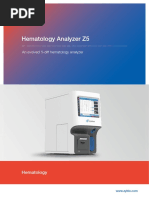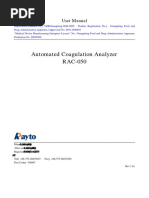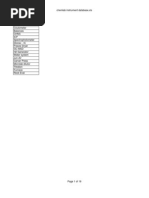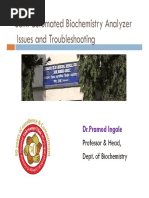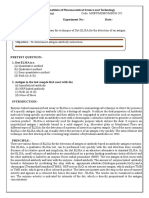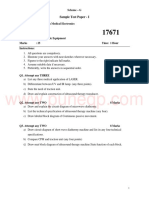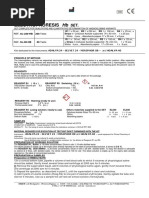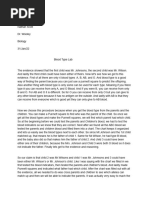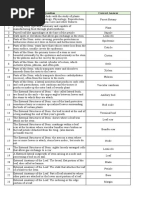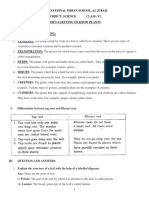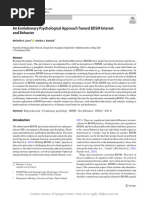(Mod. IFCC Method) For The Determination of SGOT (AST) Activity in Serum. (For in Vitro Diagnostic Use Only)
(Mod. IFCC Method) For The Determination of SGOT (AST) Activity in Serum. (For in Vitro Diagnostic Use Only)
Uploaded by
Dinesh SreedharanCopyright:
Available Formats
(Mod. IFCC Method) For The Determination of SGOT (AST) Activity in Serum. (For in Vitro Diagnostic Use Only)
(Mod. IFCC Method) For The Determination of SGOT (AST) Activity in Serum. (For in Vitro Diagnostic Use Only)
Uploaded by
Dinesh SreedharanOriginal Title
Copyright
Available Formats
Share this document
Did you find this document useful?
Is this content inappropriate?
Copyright:
Available Formats
(Mod. IFCC Method) For The Determination of SGOT (AST) Activity in Serum. (For in Vitro Diagnostic Use Only)
(Mod. IFCC Method) For The Determination of SGOT (AST) Activity in Serum. (For in Vitro Diagnostic Use Only)
Uploaded by
Dinesh SreedharanCopyright:
Available Formats
SGOT (AST) ASSAY PROCEDURE:
(Mod. IFCC method) Wavelength/ Filter : 340 nm
For the determination of SGOT (AST) activity in serum. Temperature : 37°C
(For In vitro Diagnostic Use Only) Light Path : 1 cm
Pipette into clean dry test tube labeled as Test(T)
SUMMARY:
SGOT is an enzyme found mainly in heart muscle, liver cells, skeletal muscle and kidneys. Injury to Addition Sequence Test (T)
these tissues results in the release of the enzyme in blood. Elevated levels are found in myocardial Working Reagent 1000µl
infarction, Cardiac operations, Hepatitis, Cirrhosis, acute pancreatitis, acute renal diseases, Sample 100µl
primary muscle diseases. Decreased levels may be found in Pregnancy, Beri Beri and Diabetic
ketoacidosis. Mix well and read the initial absorbance A after 1 min. and repeat the absorbance reading after
1,2 & 3 minutes. Calculate the mean absorbance change per min.( A/min).
PRINCIPLE:
SGOT (AST) catalyzes the transfer of amino group between L-Aspartate and a-Ketoglutarate to CALCULATIONS:
form Oxaloacetate and Glutamate. The Oxaloacetate formed reacts with NADH in the presence of SGOT (AST) Activity in IU/L 37°C = A /min. x 1746 x tf
Malate Dehydrogenase to form NAD. The rate of oxidation of NADH to NAD is measured as a
decrease in absorbance which is proportional to the SGOT (AST) activity in the sample. TEMPERATURE CONVERSION FACTORS:
SGOT Desired Reporting Temperature(tf)
L-Aspartate acid + a-Ketoglutarate Oxaloacetate+L-Glutamate Assay
25°C 30°C 37°C
MDH
25°C 1.00 1.37 2.08
Oxaloacetate + NADH + HMalate + NAD
30°C 0.73 1.00 1.54
CONTENTS: 37°C 0.48 0.65
PACK SIZE ENZYME REAGENT(A1) DILUENT (A2)
NORMAL REFERENCE VALUES:
6x10ml 6x10ml 60ml Serum (males) : Up to 37 IU/L at 37°C
5x20ml 5x20ml 100ml (females) : Up to 31 IU/L at 37°C
REAGENT PREPARATION: LINEARITY:
WORKING REAGENT : For sample start assays a single reagent is required. Reconstitute one The procedure is linear up to 450 IU/L at 37°C, If the absorbance change ( A /min.) exceeds
vial of enzyme reagent (A1) with equivalent Volume of diluent (A2) (mentioned on the Enzyme 0.250, use only the value of the first two minutes to calculate the result, or dilute the sample 1+9
Reagent (A1) labels with normal saline (NaCl 0.9%) and repeat the assay (Results x 10).
STORAGE AND STABILITY: NOTE:
Working reagent: This working reagent is stable for at least 4 weeks when stored at 2-8°C. Samples having a very high activity show a very low initial absorbance as most of the NADH is
consumed prior to the start of measurement. If this is suspected then dilute the sample and
SAMPLE MATERIAL: repeat the assay.The working reagent or the combined reagent should have an absorbance
Serum. Free from hemolysis. SGOT (AST) is report to be stable in serum for 3 days at 2-8°C. above 1.0 against distilled water at 340 nm. Discard the reagent if the absorbance is below 1.0.
GENERAL SYSTEM PARAMETER: It is recommended that each laboratory establish its own normal range representing its patient
population.
Reaction Mode U.V Kinetic Sample Volume 100 µl
Wavelength 340 nm Reagent volume 1000 µl REFERENCES:
Blank Distilled Water Factor 1746 IFCC methods for the measurements of catalytic concentrations of enzymes, J. Clin. Chem.
Clin. Biochem. (1986) 24: 497
Incubation 37°C Reaction Slope Decreasing
Delay Time 60 sec Linearity 450 IU/L
Read Time 180 sec Units IU/L
You might also like
- Chemiluminescence As Diagnostic Tool A ReviewDocument26 pagesChemiluminescence As Diagnostic Tool A ReviewDian AmaliaNo ratings yet
- Equ28-01 Sysmex XE2100 Op SOPDocument16 pagesEqu28-01 Sysmex XE2100 Op SOPWasim AkramNo ratings yet
- Instructions For Use TSHDocument12 pagesInstructions For Use TSHBenjamin MannNo ratings yet
- MEDICA 2017 Wheisman Medical Technology Co. LTD Paper Medcom2017.2556129 8ayslvd2RMGitd8KwWyLkw PDFDocument4 pagesMEDICA 2017 Wheisman Medical Technology Co. LTD Paper Medcom2017.2556129 8ayslvd2RMGitd8KwWyLkw PDFim the only100% (1)
- SGOTDocument2 pagesSGOTDinesh Sreedharan0% (1)
- Alkaline Phosphatase KitDocument2 pagesAlkaline Phosphatase KitDinesh SreedharanNo ratings yet
- 1 Medical TerminologyDocument6 pages1 Medical TerminologyFatzie MendozaNo ratings yet
- Sgot (S.L) : Agappe Diagnostics LTDDocument2 pagesSgot (S.L) : Agappe Diagnostics LTD0129684769No ratings yet
- Truechemie: Hba1C Test KitDocument2 pagesTruechemie: Hba1C Test KitAniket dubeyNo ratings yet
- Hematology Analyzer Z5: Technical SpecificationDocument6 pagesHematology Analyzer Z5: Technical SpecificationSmart BiomedicalNo ratings yet
- REVO-VP 5000 User ManualDocument38 pagesREVO-VP 5000 User ManualMiro SekulaNo ratings yet
- Trima Accel Blood Collection SystemDocument3 pagesTrima Accel Blood Collection SystemIRFAN KHANNo ratings yet
- Automated Coagulation Analyzer RAC-050: User ManualDocument77 pagesAutomated Coagulation Analyzer RAC-050: User Manualyousra zeidanNo ratings yet
- Chemistry InstrumentsDocument19 pagesChemistry Instrumentshani1986yeNo ratings yet
- DNA Isolation From Spleen ProtocolDocument2 pagesDNA Isolation From Spleen ProtocolSherlock Wesley ConanNo ratings yet
- D-Dimer Rapid Quantitative TestDocument2 pagesD-Dimer Rapid Quantitative TestSarah Ahmed50% (2)
- Mispa I3 User ManaualDocument52 pagesMispa I3 User Manauallemanhcuong1503No ratings yet
- Aleesha Livingston L Ap/Ece/BioeDocument6 pagesAleesha Livingston L Ap/Ece/BioeAleeshaNo ratings yet
- Glucose c111 RocheDocument3 pagesGlucose c111 RocheHarditya FirdhausNo ratings yet
- Semi-Automated Biochemistry Analyzer I D T Blhti Issues and TroubleshootingDocument18 pagesSemi-Automated Biochemistry Analyzer I D T Blhti Issues and TroubleshootingManjunath K S RaoNo ratings yet
- Assignment of Clinical Laboratory Rotations-I'Document12 pagesAssignment of Clinical Laboratory Rotations-I'Suleman MalikNo ratings yet
- Amylase Arc ChemDocument8 pagesAmylase Arc Chemmalyaban mitraNo ratings yet
- UV Vis InstrumentationDocument17 pagesUV Vis InstrumentationKD LoteyNo ratings yet
- SP100 OcrDocument36 pagesSP100 OcrMiguel CoriaNo ratings yet
- I STAT 1 User Guide VTS 00022Document42 pagesI STAT 1 User Guide VTS 00022winner10thjulyNo ratings yet
- Mispa CXL Pro PlusDocument2 pagesMispa CXL Pro Plusprasanth gNo ratings yet
- Swelab Alfa Plus Brochure PDFDocument6 pagesSwelab Alfa Plus Brochure PDFShine June B. CorpuzNo ratings yet
- Titrimetric Methods of AnalysisDocument82 pagesTitrimetric Methods of AnalysisMeseret KifileNo ratings yet
- Creatinine - EnzymaticDocument2 pagesCreatinine - Enzymaticpsychejane100% (1)
- To Calibrate Absorbance Scale and Detect Stray Light in An UV/Vis SpectrophotometerDocument2 pagesTo Calibrate Absorbance Scale and Detect Stray Light in An UV/Vis Spectrophotometerdhungelsubhash8154100% (2)
- Dot-ELISA Practical Manual 2Document4 pagesDot-ELISA Practical Manual 2Anusua RoyNo ratings yet
- Urea Nitrogen AnalyzerDocument16 pagesUrea Nitrogen AnalyzerSkywalker_92No ratings yet
- Beckman Coulter Manual ProcDocument14 pagesBeckman Coulter Manual ProcWihadi Santoso Indra SusenoNo ratings yet
- Complement Fixation Test تقرير د-حيدر-محولDocument5 pagesComplement Fixation Test تقرير د-حيدر-محولYASMINANo ratings yet
- Chem200 Service Manual 2-32 - 240209 - 091706Document159 pagesChem200 Service Manual 2-32 - 240209 - 091706Okura JoshuaNo ratings yet
- Ecl 760 Fully Automated Random Access Coagulaon AnalyzerDocument2 pagesEcl 760 Fully Automated Random Access Coagulaon AnalyzerTrần Văn BìnhNo ratings yet
- Rocket Immunoelectrophiresis Practical ManualDocument4 pagesRocket Immunoelectrophiresis Practical ManualAnusua RoyNo ratings yet
- ALT Practical Handout For 2nd Year MBBSDocument4 pagesALT Practical Handout For 2nd Year MBBSfreddy fitriady100% (1)
- Matrix Gel System PDFDocument49 pagesMatrix Gel System PDFArchi Claresta AprilinoNo ratings yet
- Neurology Mosaics Instructions For The Indirect Immunofluorescence TestDocument24 pagesNeurology Mosaics Instructions For The Indirect Immunofluorescence Testnbiolab6659No ratings yet
- ESTIMATION OF SERUM UreaDocument4 pagesESTIMATION OF SERUM Ureasoroutaditya04No ratings yet
- Estimation of Serum Creatinine: Jaffe'S MethodDocument20 pagesEstimation of Serum Creatinine: Jaffe'S MethodAnjuNo ratings yet
- Package Insert 13695 - HCG D - en - 30405-01 PDFDocument10 pagesPackage Insert 13695 - HCG D - en - 30405-01 PDFadybaila4680No ratings yet
- 1002ue 2022-02 PDFDocument129 pages1002ue 2022-02 PDFJorge Antonio Negretty Moreno50% (2)
- Urea Urease-GLDH Kinetic (UV) Package InsertDocument2 pagesUrea Urease-GLDH Kinetic (UV) Package InsertpsychejaneNo ratings yet
- ALP Single ReagentDocument2 pagesALP Single ReagentJames 'jps' SimanjuntakNo ratings yet
- Chorus Trio: Service MenuDocument151 pagesChorus Trio: Service MenuАлексей ЖижченкоNo ratings yet
- 1373UE Hum Asy 3Document238 pages1373UE Hum Asy 3gabriel.r.henriquezNo ratings yet
- User Manual Chorus Trio 3.2 e 4.0 Rev 1.3 06.2016 enDocument132 pagesUser Manual Chorus Trio 3.2 e 4.0 Rev 1.3 06.2016 enluisoft88No ratings yet
- Instrumental Methods of Analysis Question Bank For B Tech BiotechDocument3 pagesInstrumental Methods of Analysis Question Bank For B Tech BiotechJency BavithraNo ratings yet
- Therapeutic Equipment PDFDocument5 pagesTherapeutic Equipment PDFPrashant KasarNo ratings yet
- Celltac MEK 6500Document3 pagesCelltac MEK 6500RiduanNo ratings yet
- GE300 Electrolyte Analyzer-20181211Document2 pagesGE300 Electrolyte Analyzer-20181211Mahamad MahmndarNo ratings yet
- 5 - 8 - 2013 - User Manual - Readwell STRIP - 3.4ADocument45 pages5 - 8 - 2013 - User Manual - Readwell STRIP - 3.4AReach Business Software Pvt Ltd100% (1)
- Electrophoresis: 200 Tests R1 R2 R3 R4Document2 pagesElectrophoresis: 200 Tests R1 R2 R3 R4Wolaé Mathurin Edmond AmegandjinNo ratings yet
- Sedy12 ESR Manual U - E12 - NNDocument20 pagesSedy12 ESR Manual U - E12 - NNSmart BiomedicalNo ratings yet
- RX Imola: A Fully Automated Clinical Chemistry AnalyserDocument22 pagesRX Imola: A Fully Automated Clinical Chemistry AnalyserRaj BnNo ratings yet
- Alphadia Blue DiverDocument4 pagesAlphadia Blue DiverSami AryanNo ratings yet
- Thermo Hygrometer Clock HTC-2: FeaturesDocument2 pagesThermo Hygrometer Clock HTC-2: FeaturesSheila Ulina100% (1)
- Compilation of Formula: Clinical ChemistryDocument4 pagesCompilation of Formula: Clinical ChemistryJillan MarieNo ratings yet
- C.F.A.S. Hba1C: English System InformationDocument2 pagesC.F.A.S. Hba1C: English System InformationtechlabNo ratings yet
- Mindray Coagulation Reagent PT, APTT, FIB, TT BrochureDocument1 pageMindray Coagulation Reagent PT, APTT, FIB, TT BrochureAIINo ratings yet
- (Mod. IFCC Method) For The Determination of SGPT (ALT) Activity in Serum. (For in Vitro Diagnostic Use Only)Document1 page(Mod. IFCC Method) For The Determination of SGPT (ALT) Activity in Serum. (For in Vitro Diagnostic Use Only)Dinesh SreedharanNo ratings yet
- Urea Kinetic KitDocument2 pagesUrea Kinetic KitDinesh SreedharanNo ratings yet
- RF LatexDocument1 pageRF LatexDinesh SreedharanNo ratings yet
- TriglyceridesDocument1 pageTriglyceridesDinesh SreedharanNo ratings yet
- Total ProteinDocument1 pageTotal ProteinDinesh SreedharanNo ratings yet
- (Mod. IFCC Method) For The Determination of SGPT (ALT) Activity in Serum. (For in Vitro Diagnostic Use Only)Document1 page(Mod. IFCC Method) For The Determination of SGPT (ALT) Activity in Serum. (For in Vitro Diagnostic Use Only)Dinesh SreedharanNo ratings yet
- Microalbumin Turbilatex - Liquid CalibratorDocument2 pagesMicroalbumin Turbilatex - Liquid CalibratorDinesh SreedharanNo ratings yet
- BilirubinDocument1 pageBilirubinDinesh SreedharanNo ratings yet
- CalciumDocument1 pageCalciumDinesh SreedharanNo ratings yet
- (Modified Jaffe's Kinetic Method & End Point Method) For The Determination of Creatinine in Serum and Urine (For in Vitro Diagnostic Use Only)Document1 page(Modified Jaffe's Kinetic Method & End Point Method) For The Determination of Creatinine in Serum and Urine (For in Vitro Diagnostic Use Only)Dinesh SreedharanNo ratings yet
- GlycoDocument1 pageGlycoDinesh SreedharanNo ratings yet
- Triglycerides (GOP - PAP Method)Document3 pagesTriglycerides (GOP - PAP Method)Dinesh SreedharanNo ratings yet
- Cholesterol & HDL CholesterolDocument1 pageCholesterol & HDL CholesterolDinesh SreedharanNo ratings yet
- Lipase: Calib. Conc. Check Vial LabelDocument2 pagesLipase: Calib. Conc. Check Vial LabelDinesh SreedharanNo ratings yet
- Tydal S KitDocument2 pagesTydal S KitDinesh SreedharanNo ratings yet
- Urea Berthelot KitDocument2 pagesUrea Berthelot KitDinesh SreedharanNo ratings yet
- RF LatexDocument2 pagesRF LatexDinesh SreedharanNo ratings yet
- Total Protein KitDocument2 pagesTotal Protein KitDinesh SreedharanNo ratings yet
- Potassium: 20 Test 1x60mlDocument3 pagesPotassium: 20 Test 1x60mlDinesh SreedharanNo ratings yet
- SGPTDocument2 pagesSGPTDinesh SreedharanNo ratings yet
- RF TurbiDocument2 pagesRF TurbiDinesh SreedharanNo ratings yet
- Micro AlbDocument2 pagesMicro AlbDinesh SreedharanNo ratings yet
- HDL DirectDocument2 pagesHDL DirectDinesh SreedharanNo ratings yet
- Creatinine KitDocument3 pagesCreatinine KitDinesh SreedharanNo ratings yet
- Wavelength: End PointDocument3 pagesWavelength: End PointDinesh SreedharanNo ratings yet
- Cholesterol KitDocument3 pagesCholesterol KitDinesh SreedharanNo ratings yet
- ChlorideDocument2 pagesChlorideDinesh SreedharanNo ratings yet
- AmylaseDocument2 pagesAmylaseDinesh SreedharanNo ratings yet
- Reagents Are Stable at RTDocument2 pagesReagents Are Stable at RTDinesh SreedharanNo ratings yet
- r 1218534Document5 pagesr 1218534dsrocks1411No ratings yet
- CardiologyDocument220 pagesCardiologyGlorivy E. Mora GonzalezNo ratings yet
- Soal Pilgan Pas BHS Inggris 2024Document8 pagesSoal Pilgan Pas BHS Inggris 2024amat08195722No ratings yet
- YZ - Penelususran Literatur 22 2023Document9 pagesYZ - Penelususran Literatur 22 2023yasmin zahraNo ratings yet
- 03 Forces Acting On RPDDocument46 pages03 Forces Acting On RPDthoraya hassanNo ratings yet
- Body Systems WebQuestDocument5 pagesBody Systems WebQuest28sabdullahNo ratings yet
- Chap3 Eng Pressure Part1Document70 pagesChap3 Eng Pressure Part1Chuyên Mai TấtNo ratings yet
- CS5 (AGE) Acute Gastroenteritis NCPDocument2 pagesCS5 (AGE) Acute Gastroenteritis NCPAudrie Allyson Gabales100% (1)
- Autonomic Receptors AtfDocument26 pagesAutonomic Receptors AtfYounusNo ratings yet
- Watson 14Document27 pagesWatson 14brunella govettoNo ratings yet
- Sepsis and Septic Shock - Critical Care MedicineDocument2 pagesSepsis and Septic Shock - Critical Care MedicineMihaela MoraruNo ratings yet
- Blood Type LabDocument3 pagesBlood Type Labnathanmscott1000No ratings yet
- FBS TaxonomyDocument40 pagesFBS TaxonomyJoyce GomezNo ratings yet
- MemoryDocument6 pagesMemoryFernando SetionoNo ratings yet
- GETTING TO KNOW PLANTS 6th NotesDocument4 pagesGETTING TO KNOW PLANTS 6th NotesPrabhu VelNo ratings yet
- Elimination NeedsDocument52 pagesElimination NeedsKhadija JaraNo ratings yet
- Skeletal System WorksheetDocument4 pagesSkeletal System Worksheetjezhari talbotNo ratings yet
- BiochemistryDocument18 pagesBiochemistryShashanka PoudelNo ratings yet
- Cell - The Unit of Life: DPP 05 - Yakeen NEET 2.0 2025 (Alpha)Document3 pagesCell - The Unit of Life: DPP 05 - Yakeen NEET 2.0 2025 (Alpha)reva.chavanNo ratings yet
- Pharmacology Exam PrepDocument4 pagesPharmacology Exam PrepMihaela TomaNo ratings yet
- 1st Periodic Exam in Science 9Document7 pages1st Periodic Exam in Science 9shirley cortezNo ratings yet
- HM2lab4 Pre Analytical Variables and CoagulometryDocument6 pagesHM2lab4 Pre Analytical Variables and CoagulometryKaycee BiñasNo ratings yet
- Physical Education Grade 7: Patricia L. Meneses, LPT MapehDocument150 pagesPhysical Education Grade 7: Patricia L. Meneses, LPT MapehTrisha MenesesNo ratings yet
- Anatomy and PhysiologyDocument7 pagesAnatomy and PhysiologyKristine Alejandro100% (1)
- Pathophysiology The Biologic Basis For Disease in Adults and Children Mccance 6th Edition Test BankDocument17 pagesPathophysiology The Biologic Basis For Disease in Adults and Children Mccance 6th Edition Test BankAnna Jones100% (38)
- Feline Orthopaedics Second Edition Juan M. Marti 2024 Scribd DownloadDocument64 pagesFeline Orthopaedics Second Edition Juan M. Marti 2024 Scribd Downloadhafeniganboa100% (2)
- An Evolutionary Psychological Approach Toward BDSMDocument16 pagesAn Evolutionary Psychological Approach Toward BDSMtrainerbsd24No ratings yet
- Anatomical Classification of Facial, Cranio-Facial and Latero-Facial CleftsDocument24 pagesAnatomical Classification of Facial, Cranio-Facial and Latero-Facial CleftsAlvaro Jose Uribe TamaraNo ratings yet
- DURAGEN Plus Dural Regeneration MatrixDocument8 pagesDURAGEN Plus Dural Regeneration MatrixramadhaniregulatoryNo ratings yet









